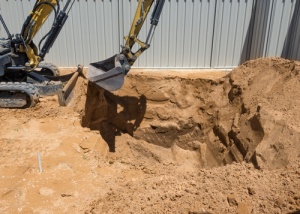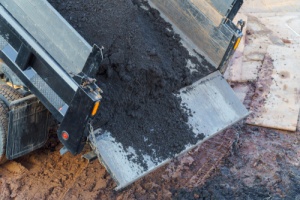It is not uncommon for homeowners to decide that they no longer want or need their pool. For some, they simply do not use it anymore and would prefer to have more space in their yard. Others have grown tired of the maintenance pool requires. Whatever the reason, many homeowners find themselves with a pool they need to remove.
Pool removals are a big project, and they can be expensive. Rather than paying someone to remove your pool, you may be wondering if you can remove it yourself.
Indeed you can, but it is a dangerous process. Before you choose to remove your pool yourself, you should take the time to understand all of the risks that you are taking if you do so. Some parts of the process are not dangerous, but are still quite difficult. We will break those down for you in this article so that you will be as well-informed as possible.
Draining the Pool
 To remove a pool, you must first drain it. The first step in draining a pool is having a plan for disposing of the water. Not every city will allow you to drain the water into the municipal water supply, the storm drains or into the street.
To remove a pool, you must first drain it. The first step in draining a pool is having a plan for disposing of the water. Not every city will allow you to drain the water into the municipal water supply, the storm drains or into the street.
Your pool contains far too much water to simply drain it into your lawn, and you do not want all of the pool chemicals in your lawn anyway. Most of the time, you need to drain your pool through your home’s sewer cleanouts.
Check with your local water authority, though, as they sometimes only allow pool draining at certain times.
You will also need to allow the pool chemicals to dissipate. This is legally required in most cities- the water must be chlorine-neutral with a neutral pH. Essentially, you need to stop adding chemicals to your pool and wait until the water tests as chemical-free before you are allowed to drain it.
Electrical and Gas Lines
You are going to be using some heavy equipment and digging up parts of your yard. There is a very real risk that you could damage, cut or rupture power or gas lines while removing your pool.
Doing so would cause multiple problems. First, there would be the obvious inconvenience of losing power unexpectedly. Then, there would be the expense of having those lines repaired.
Most importantly, though, is a danger to you. Making contact with a damaged power line could cause electrocution, and rupturing a gas line could cause an explosion or a fire. Before you begin working, make sure that you know where all of these lines are and that you have clearly marked them in your lawn.
Renting Equipment for Demolition and Debris Hauling
 It is unlikely that you own all of the equipment that you will need for a pool removal.
It is unlikely that you own all of the equipment that you will need for a pool removal.
Removing a pool requires breaking up all of the concrete and other pool materials into manageable pieces, and hauling them away. Even if you choose to simply fill in the pool with dirt, you will need to break up the concrete near the top of the pool, and punch holes through the concrete at the bottom to ensure proper drainage.
Either way, you will still have to have the area where the pool was filled in with gravel and soil, which means you will need to have that hauled in, and you will need the equipment to compact it properly.
You need equipment to break up the concrete. You need equipment to remove the concrete from the pool and loaded into a truck to haul it away. You need a truck to haul it away in. You need a truck to haul the fill dirt in. You need equipment to move the fill dirt from the truck into the hole where the pool was. The need equipment to compact the dirt.
The cost of renting all of that equipment will add up fast. There is no guarantee that you will actually save money by removing your pool yourself, since you will have so many rental expenses.
Removing the Pool Pump
This is a relatively simple task that many pool owners have likely undertaken before. Still, it is one more thing you have to do if you are handling your pool removal yourself. Any additional task on your to-do list at this point can end up becoming a problem.
Disposing of the Debris
 Once you have demolished your pool, you will have at least one huge truckload of debris. Concrete, fiberglass, rebar, and other materials. You now have to dispose of these things. Will the local dump take them? If they will, how exactly are you going to do that?
Once you have demolished your pool, you will have at least one huge truckload of debris. Concrete, fiberglass, rebar, and other materials. You now have to dispose of these things. Will the local dump take them? If they will, how exactly are you going to do that?
You hopefully already have the truck at that point, but once you have hauled all of that debris to the dump, how are you going to get it out of the truck? The dump may not be able or willing to assist you.
Filling in the Hole
At this point, you will now have a large, empty hole in your yard. You need to fill it in. You will need the dirt to fill the hole, and then you will need to compact and grade the dirt so that the ground is level and safe.
All of this requires more equipment, more time, and might be beyond your level of expertise.
As you can see, removing your pool yourself is a challenging, dangerous, and expensive task. It is a large and complex project that can take days or weeks to do on your own, and it might not save you as much money as you think.
If you have a pool that you need removed, it is well worth the time to contact a professional and find out how much it will cost you to have them do it.
A professional pool removal service will handle all of the tasks listed above. They break up the concrete, remove the debris and the pump, handle the pool draining, fill in and grade out the soil, and already have all of the equipment necessary for the job. Contact the pool removal contractors at Dirt Connections if you have any more questions about the process or would like more information about their pool removal services.








































